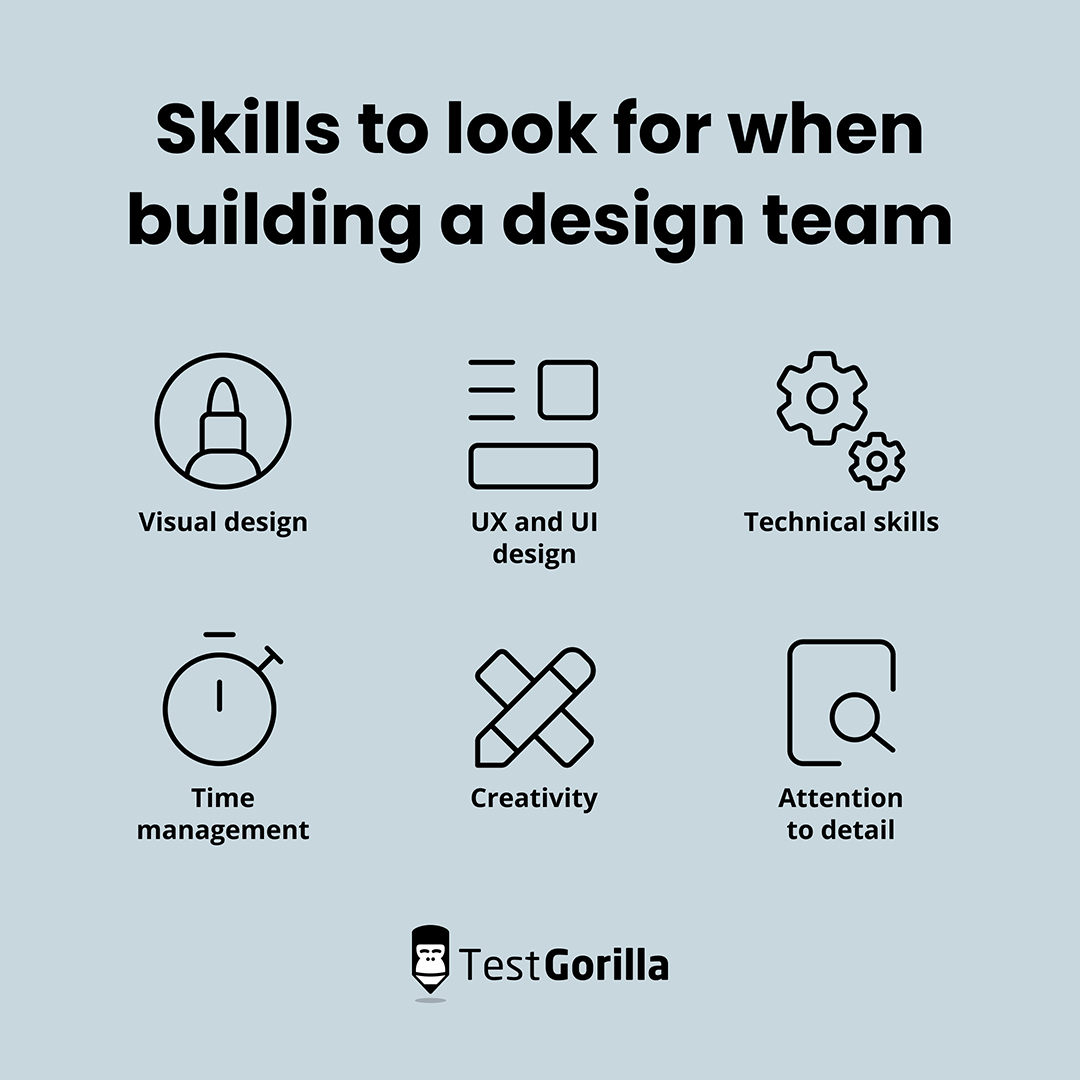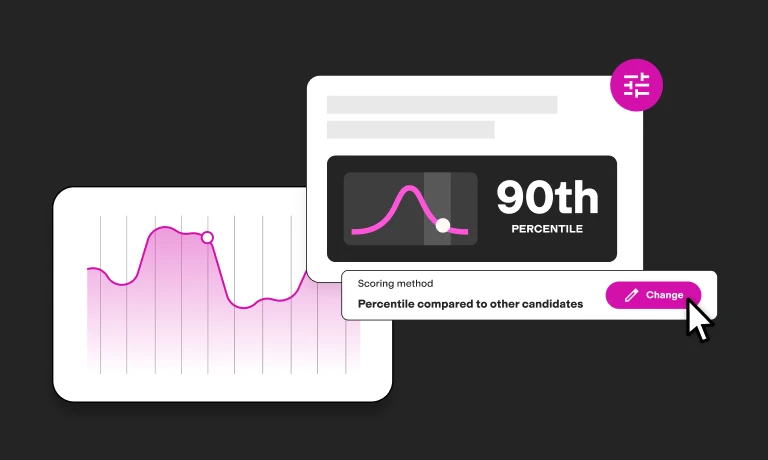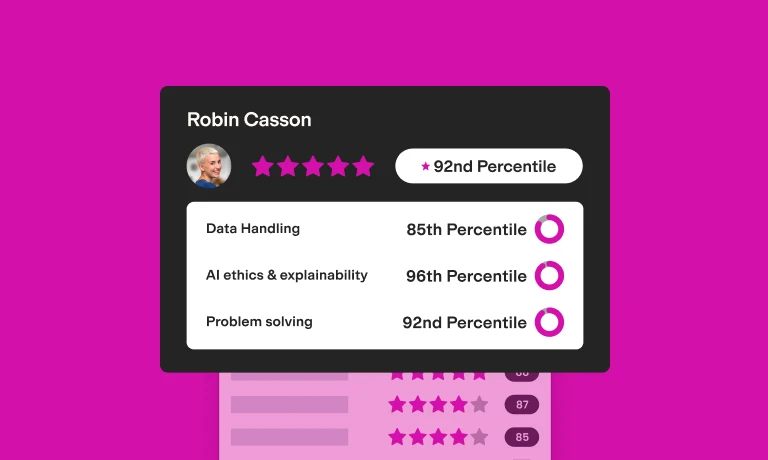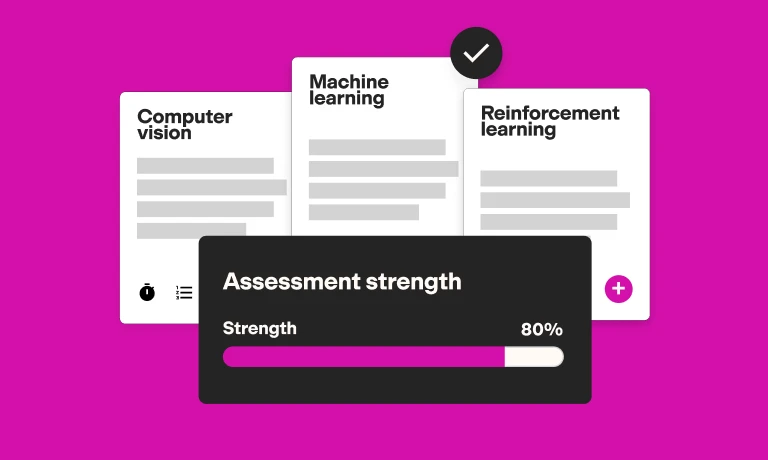Our brains pick up visual cues faster than they read text.
When you look at an ad or a website, before you get to the words, you will already have strong impressions based on the images you see – and that will inevitably affect your opinion.
Design is an essential marketing component; many clients assess a company’s credibility based on the business’ web page. So, to boost your sales, focus on the visual aspects of your marketing campaigns and ensure they align with your vision.
To do that, you must hire skilled designers and build a talented design team. Regardless of whether your team will focus on graphic, product, or industrial design (or a mix of those), hiring the right people will transform the way your customers see your business.
In this step-by-step guide, we will help you optimize your hiring process and build the best design team for your organization. We’ll cover:
What design teams do
Key roles in design
Skills you need to look for
How to assess these skills
What team structure to pick
Where to source reliable candidates
Recommended interview questions for designers
What do design teams do?
Context and business needs will define the role of your design team. One thing that remains constant for any design team is that it consists of designers, managers, and sometimes researchers who work together to build a unified vision of a product or brand.
The vocabulary surrounding the different job roles in design can be confusing. What is expected from a UI designer in one organization isn’t the same as what is expected in another. That’s why it’s best to focus on a combination of skills and personality traits, rather than on degrees or past experience with a specific process or tool.
No matter what your project is, you usually need the people on your design team to:
Conduct user interviews
Run user testing sessions
Create low-fidelity and high-fidelity prototypes and storyboards
Build design concepts and visual assets
Refine and update designs
What are the most essential roles in a design team?
To build a successful design team, you need to hire a few design professionals with different responsibilities and specific areas of expertise.
Who you hire will depend on your company’s needs and your specific project, but some key roles usually have their place in every design team.
Here are the most common roles in design teams that work on digital products or marketing assets such as apps or websites:
UX designer
UX designers focus on building logical and intuitive user paths and creating a positive user experience (UX). They work on the overall feel of your digital product and make sure it’s built in a way that is easy to navigate.
Some of their main duties include to:
Create high-fidelity screens and prototypes that show how the product will look and function once it’s released
Translate concepts into user paths and wireframes
Build a design that provides an intuitive and efficient user experience
Facilitate the company’s (or client’s) product vision
UI designer
UI designers focus on the visual interface of your product (UI is short for user interface). They need to create aesthetically pleasing screens. While UX designers focus more on functionality, UI designers work to make your product look good.
UI designers:
Develop visual concepts based on your vision
Turn them into layout by picking various images, typography, and other design elements
Create storyboards and sitemaps for the process flow
UX researcher
UX researchers research target users to collect data, guiding the design process and enabling the rest of the team to create designs that appeal to clients. Some of their key responsibilities are to:
Create buyer personas
Conduct research such as user interviews or A/B testing
Track customer feedback
Identify user needs by analyzing data
Design objectives
UX copywriter
UX copywriters are also known as content strategists, even though that term has picked up other meanings now and can’t be accurately used for this job role anymore.
Their main objective is to write text for the user interface to guide the users through it and create a seamless experience.
Some of the types of copy they are responsible for include:
Errors messages
Notifications
Buttons
Instructions
Onboarding sequences
Form fields
Design manager or director
The design manager (or director) acts as a design lead, building strategies and overseeing their execution to ensure the design process runs smoothly.
They are responsible for making final decisions after all team members have presented their ideas and work – and for making sure the project is headed in the right direction.
Design strategist
The design strategist uses research on customer preferences and market trends to create practical design approaches. Most importantly, they ensure that the design strategies they develop are in sync with the company’s goals.
They bridge the gap between the users' desires and the business's objectives by ensuring that each design initiative is both appealing to the user and beneficial for the business. (This is why most design strategist job descriptions highlight the need for the strategist to balance customer needs with company goals.)
The best insights on HR and recruitment, delivered to your inbox.
Biweekly updates. No spam. Unsubscribe any time.
Skills to look for when building a design team
Before considering the roles you should be hiring for, try to be clear about the outcomes you expect your design team to deliver.
After you set your mind on your objectives, think about what skills are required to achieve these goals.
Hard skills are critical, but you shouldn’t pass on soft skills either – according to the World Economic Forum (WEF), the five most important skills in 2023 are, in fact, cognitive abilities, such as analytical and creative thinking, motivation, self-awareness, and lifelong learning.
Here are some of the skills we consider to be essential when you’re building a design team.
Visual design
Visual and graphic design are two terms often used interchangeably, especially outside of the design industry, but they mean slightly different things.
Visual design focuses on the aesthetics of a site or product, emphasizing elements like colors, images, and typography. Graphic design involves creating and combining images and text to communicate messages in various media.
When hiring a design team, you must look for people with strong visual design skills. This means they must possess solid knowledge of design elements such as layout, typography, color theory, and branding. They must be able to do hand-drawn sketches, upload them, and create 2D and 3D renders.
UX and UI design
The user experience is critical when you’re selling an online product or service. This is why you must hire a design team with strong UX (user experience) and UI (user interface) design skills.
Look for professionals who can:
Create wireframes, prototypes, mockups, and user flows
Prioritize and organize complex sets of information and define the right information architecture
Use their design skills to create intuitive and seamless designs for digital products
Build aesthetically pleasing user interfaces
Technical skills
There are a variety of technical skills your design team must possess – and software tools they must be proficient in – but it all depends on the type of project they’ll be working on.
If your company focuses primarily on one type of service, such as building websites for other businesses, proficiency in web design software may be sufficient. However, if your scope of services is more extensive, consider hiring a design team with broader software expertise.
Some of the most common software tools that a design team uses are:
Adobe Creative Suite (Photoshop, Illustrator, InDesign)
Sketch
Figma
Webflow
Canva
Time management
Design briefs are usually accompanied by deadlines. However, design work can be unpredictable; for example, designers might have to make multiple iterations and revisions before the final result is approved.
That’s why time management is a critical skill for a design team. It enables every team member to:
Plan ahead
Use their time efficiently
Prioritize tasks
Meet deadlines consistently
Creativity
Design teams might have to work on projects that are very different from each other. That’s why they can’t develop a magical solution or formula that works in every case. They need to be creative to create compelling designs.
Every design team needs to adhere to their clients’ or managers’ instructions and keep in mind limiting factors while using their imagination to build innovative and captivating designs.
Attention to detail
Having an eye for detail is always beneficial for people in design teams. This means you can spot and fix errors easily and give your work that extra something that just makes it pop and stand out among the competition.
The design process is complex, and various factors must be considered. People who pay close attention to details can:
Incorporate design elements that improve functionality and productivity
Create compelling designs
Deliver error-free work
How to build a successful design team: A step-by-step guide
Every company has a unique culture and offers something different. That’s why we can’t provide you with the exact blueprint for building your company’s design team; that’s a formula you must create for yourself.
That said, you can streamline the process of creating that formula. Structuring your design team hiring process will help you build a strong and talented team that suits your company’s needs and goals.
Here’s how to do that:
Step 1: Define the structure of your future design team
Your design team’s structure defines its functioning, so you must carefully decide which is best. Your team’s size and hierarchy will depend on your company’s objectives and company culture.
The three main types of design-team structures are:
1.Centralized structure
This is the most traditional approach. The design team functions like an internal agency with a pyramid-like structure, reporting to a lead responsible for all major decisions.
This is a great option for small or medium-sized teams. In big teams, leaving key decisions to one person or only a few people can limit the entire team’s creativity and even function like a bottleneck.
Some of the key roles in a centralized design team are:
Head of design
Team managers
Designers
2. Embedded structure
Embedded, cross-functional teams are the opposite of centralized teams. There is no designated person in charge. Instead, there are multidisciplinary teams where designers work alongside professionals from various other departments involved in the project.
This structure is particularly useful for large companies.
The embedded team might consist of:
Project manager
Designers
Web developers
Product developers
3, Flexible structure
The flexible structure is a combination of both. Designers are still embedded in larger multidisciplinary teams that focus on specific objectives. However, unlike in embedded teams, they report to a design director.
This team structure is easily adjustable, making it a great choice for projects that have many variables. However, it’s not recommended for larger companies because it can be hard to manage resources.
Step 2: Identify the roles for which you need to hire
Defining the best structure for your design team will help you identify the roles for which you need to hire.
Keep in mind that not all roles will require a full-time employee. If your design team has an embedded or flexible structure, consider hiring freelancers on a project basis.
Step 3: Define key design skills for each role
Next, you need to identify critical skills for each role on your team. This will help you hire the right employees.
Here are two examples:
UX designer skills
Prototyping and wireframing
Proficiency in design software such as Adobe InDesign, Figma, and more
Creativity
Design manager skills
Problem solving
Step 4: Source design team candidates
You can start sourcing candidates now that you know what you’re looking for. Here are some platforms that we recommend using for hiring a design team:
LinkedIn: The largest social network for professionals offers a large and diverse talent pool.
Betterteam: With this platform, you can post your job ad for free on over a hundred job boards.
Dribbble: On Dribbble, you can connect to millions of top designers from all over the world.
99designs: Here, you can connect to designers who can create all types of design assets, such as logos, illustrations, and websites.
DesignCrowd: On DesignCrowd, you can post your project, describe what you need, and receive applications from designers.
Step 5: Evaluate design skills
The next step is filtering your candidates. It’s not hard to put exaggerated claims on your resume – so how do you know who has the skills you need?
It’s best to implement different methods to maximize the efficiency of your hiring process,
Pre-employment skills testing provides a direct insight into your candidates’ current level of proficiency in different cognitive and job-specific skills. It’s a standardized way of retrieving accurate data to help you make an informed hiring decision.
Build a skills assessment of up to five job-relevant tests for each role to build the best design team.
Recommended tests for design teams
Here are our recommendations for skills tests you can use to hire a talented design team:
UX/UI design: Evaluate your candidates’ overall UX/UI design process knowledge.
Figma: Make sure your applicants are proficient with Figma.
Adobe Photoshop and Adobe InDesign: Assess candidates’ skills with two of the most popular Adobe design software tools.
Time management: Identify candidates who can manage their time well and meet deadlines consistently.
Attention to detail (visual): Assess your candidates’ ability to pay close attention to visual information and visual cues.
Communication: This test will help you find candidates who communicate effectively in a professional setting.
Step 6: Use the right design interview questions
Once you shortlist your best candidates, you can invite them to an interview for a more detailed evaluation of their skills and experience. Here are some questions you can ask:
Can you provide an example of a challenging design project you worked on?
What is your approach to collaborating with coworkers from other teams with no design background?
Imagine you're working on three urgent projects, all with due dates in the next few days. How do you prioritize your tasks?
Can you describe a successful design project in which you played a central role?
How do you ensure your designs are user-friendly and accessible?
What's your favorite project from your portfolio? Can you explain your design choices?
What are your thoughts on minimalism in design?
Can you describe a design trend you dislike? Explain why.
If you need more ideas, check out our selection of the best 45 interview questions for graphic designers or 16 interview questions for visual designers.
Step 7: Hire and onboard new employees
After you’ve collected enough data about your candidates, you can pick the most suitable ones and make an offer.
This doesn’t mean the hiring process is completed; onboarding is just as important as the rest of the process. Make sure to get other employees involved as well.
Optimize your hiring process to build a skilled design team
Forming a top-notch design team is a challenging task. Technical skills, creativity, collaboration, and alignment with your company culture are some of the many factors to consider.
Skills assessments enable you to build an objective, data-driven hiring process. This, in turn, helps you make the best choices for your company and build a highly qualified design team.
Try pre-employment skills testing today with TestGorilla’s free plan. Learn more about creating tailored skills assessments by signing up for your free live demo with a member of our team.
You've scrolled this far
Why not try TestGorilla for free, and see what happens when you put skills first.















